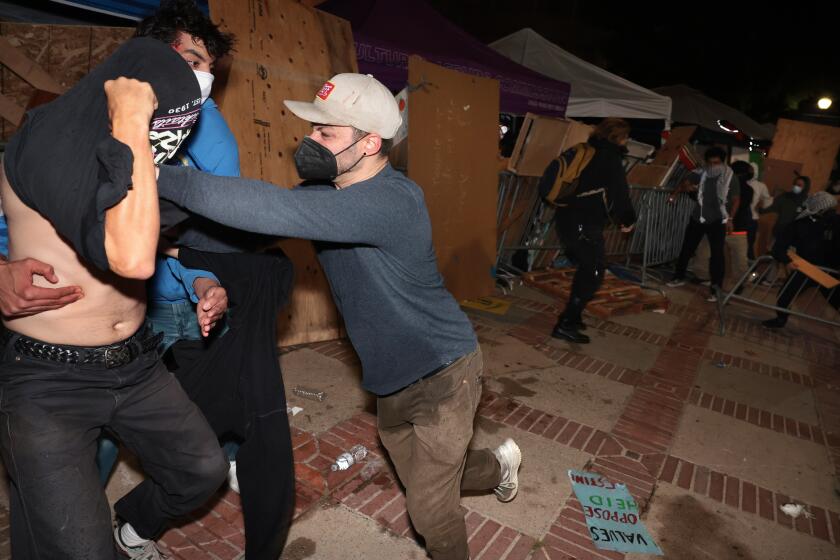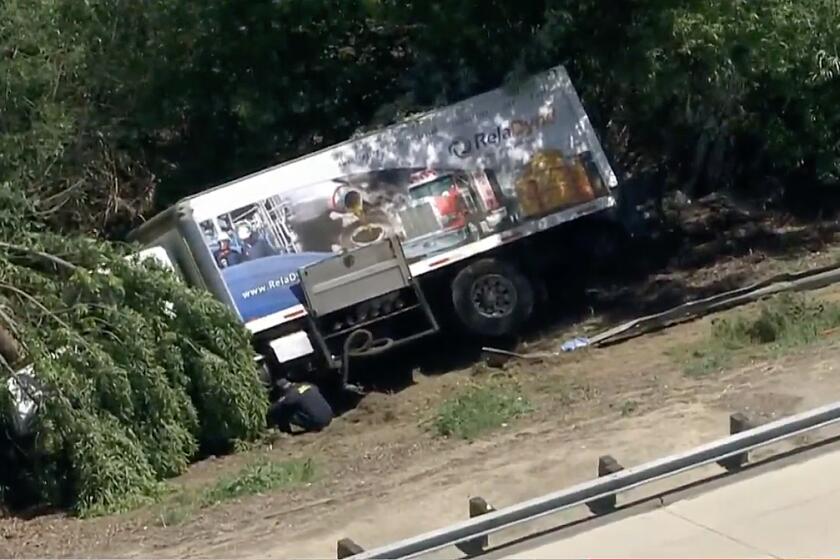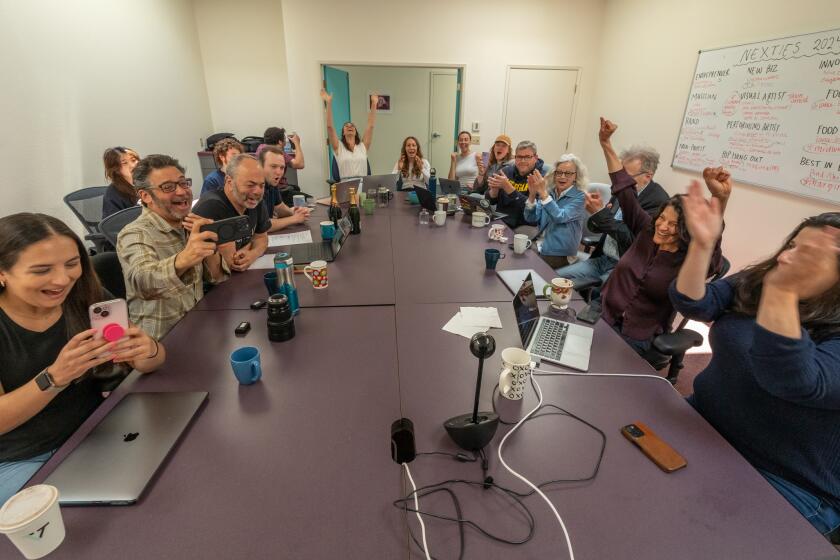Population Flood Is Slowing to a Trickle : Growth: The boom days of the past 30 years are over. Experts expect the number of people in local cities to grow less than 1% a year over the next 17 years.
After booming for much of the last 30 years, the San Gabriel Valley’s population growth has slowed to a trickle.
Last year almost all of the San Gabriel Valley’s 29 cities grew by 1% or less, according to state Department of Finance figures released last month.
Even in the east valley, where Diamond Bar and Walnut mushroomed 91% and 133% respectively during the 1980s, growth has not exceeded 2% annually the past few years.
And cities expect even slower growth through 2010, according to the Southern California Assn. of Governments, a regional planning agency that collected the statistics.
Planners expect the San Gabriel Valley to grow by a modest 10.5% by 2010. That’s less than 1% a year.
In decades past, the valley grew rapidly from west to east. But in the 1980s, when sprawling tracts were filling the last big plots in the east valley, most valley cities had their last growth spurts of 20% to 40%.
The wide-open spaces are virtually gone, and growth that comes now will mean higher-density development, planning experts say.
Local and regional planners do not envision walls of high-rise apartment complexes or massive condominium projects sweeping the valley, however.
“Twenty-story high-rises are not the future of the San Gabriel Valley,” says developer Randall Lewis, executive vice president of Lewis Homes, which has been building housing since the 1950s.
Instead, he and many city planners say, the west San Gabriel Valley will see some apartment projects near downtown areas or along proposed light-rail corridors.
Most of the growth will come in the form of “in-fill,” when an older home on a large lot is razed and replaced by several units, such as duplexes, or by homes with small or no yards.
In the built-out city of Alhambra, where the population surged by 27% during the 1980s, growth didn’t even amount to 1% last year compared to 1991. Officials there project its population will continue to increase by about 1% or so a year, but the city will still have to absorb an estimated 10,000 new residents by 2010.
“What growth we’ll have will be in-fill projects or an increase in family size--there will either be more families (in more units) living in the same space or larger families living in the same homes,” said Michael Martin, Alhambra’s acting director of community development.
Pasadena, the most urban of the valley’s cities, is the most likely location for high-rise apartments, planners said.
“As long as jobs grow, there will be an increasing demand for increased density,” said Don Nollar, Pasadena’s director of planning, building and neighborhood services.
He and other west valley planning officials share a vision: combined commercial and residential developments near the route of the proposed Blue Line extension through the western foothill cities. The light rail is expected to reach Pasadena by 1996 and a planned but unfunded extension would run to Irwindale.
Some business experts are not so sure that there will ever be adequate demand for such mixed-use development, where several stories of housing units are built above commercial centers.
“I just don’t see the high density along the transportation corridors,” said Richard Wright, Mt. San Antonio College’s dean of economic development. “I don’t think that’s where people want to live or how they want to live.”
In the east valley, where the remaining available land is on hillsides, planners say growth will come in the form of more densely clustered single-family homes or, in older communities, in-fill projects.
While open land for housing tracts has all but disappeared throughout the east valley, old school sites, strawberry fields and some hillsides will be developed over the next 20 years, officials said.
“Everyone has developed the easy sites and only the tough ones are left,” said Jeff Collier, West Covina’s planning director. “We’ll have a few hillside subdivisions but that will be the last of the vacant land.”
Today, the estimated population of the San Gabriel Valley’s 29 cities is slightly more than 1.3 million. It will increase 10.5% to roughly 1.5 million by the year 2010, according to population projections from all cities.
In addition, more than 122,000 people live in the San Gabriel Valley’s unincorporated communities, according to the 1990 Census, the latest figures available.
In Los Angeles County, today’s population of about 9.2 million is expected to increase to 10 million in 2000--about an 8% increase--and to 10.8 million in 2010, about a 14.8% increase from today.
Some San Gabriel Valley officials lament that the inevitable population growth will strain their budgets because new services will have to be provided at a time when cities are struggling to preserve basic services such as police and fire protection.
“Adding additional people to this valley is putting us through some growing pains and is very difficult,” San Dimas Mayor Terry Dipple said.
“We see it in crime stats, freeway congestion, air quality and solid waste management. Cities are saying we don’t have any vacant land and, if so, how can we grow. The only other way is redevelopment and it’s very sensitive when you go into neighborhoods and tear down older homes for new housing.”
Sensitive to the community backlash that often accompanies plans for higher-density development in single-family neighborhoods, San Dimas and other cities are “down-zoning” some areas. In many cases, neighborhoods of single family homes are now zoned for higher density development, city officials said.
Cities are identifying areas where some higher density development--including apartments, clustered housing or duplexes--has been built and are leaving the nearby area zoned for such density.
In other areas, where the land is zoned for higher density but has only been used for single-family homes, perhaps three to an acre, the zoning is being decreased to preserve the existing density.
When projecting populations, planners take into account factors such as past population growth, vacant land, land not zoned for housing but which could be, ethnicity of the population, average family size, income level and the potential for job growth.
San Gabriel Valley Population
Percent Estimated Percent Estimated of change 1993 by 2000 of change by 2010 from 1993 Alhambra 84,900 90,190 5.9 95,740 11.3 Arcadia 49,200 50,700 3.0 53,230 7.6 Azusa 42,300 45,000 6.0 47,000 10.0 Baldwin Park 71,200 73,716 3.4 76,840 7.3 Bradbury 850 870 2.3 890 4.5 Claremont 32,700 33,500 2.4 34,225 4.5 Covina 43,900 45,107 2.7 47,007 6.6 Diamond Bar 54,300 56,000 3.0 60,000 9.5 Duarte 21,100 22,938 8.0 25,188 16.2 El Monte 110,500 113,334 2.5 118,216 6.5 Glendora 49,100 50,597 3.0 53,235 7.8 Industry 680 433 -36.3 433 -36.3 Irwindale 1,050 1,218 13.8 1,450 27.6 La Puente 38,900 41,226 5.6 43,062 9.7 La Verne 31,350 34,800 9.9 34,800 9.9 Monrovia 36,900 37,201 .8 38,987 5.4 Monterey Park 62,100 66,861 7.1 73,638 15.7 Pasadena 134,400 142,195 5.5 152,798 12.0 Pomona 137,300 140,950 2.6 152,895 10.2 Rosemead 52,900 59,500 11.1 64,000 17.3 San Dimas 33,500 34,000 1.5 38,000 11.8 San Gabriel 37,950 40,206 5.6 45,000 15.7 San Marino 13,000 13,049 .38 13,079 .60 Sierra Madre 10,850 11,810 8.1 12,991 16.5 South El Monte 21,250 21,294 .2 21,719 2.2 South Pasadena 24,300 25,372 4.2 26,386 7.9 Temple City 31,950 34,990 8.7 36,366 12.1 Walnut 30,300 30,340 .13 30,340 .13 West Covina 98,200 104,000 5.6 110,000 10.7
Sources: Estimated 1993 populations are from the California Department of Finance. Projected populations for the years 2000 and 2010 are from the Southern California Assn. of Governments, which gathered this information from individual cities.
More to Read
Start your day right
Sign up for Essential California for news, features and recommendations from the L.A. Times and beyond in your inbox six days a week.
You may occasionally receive promotional content from the Los Angeles Times.






